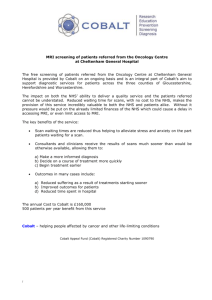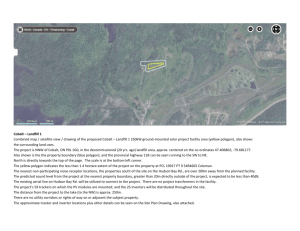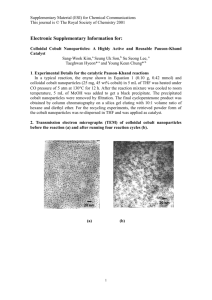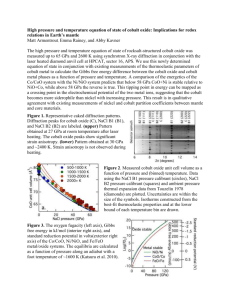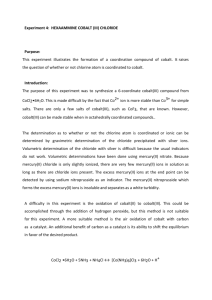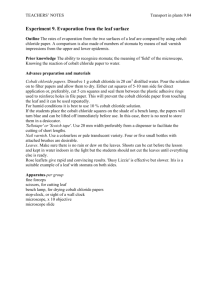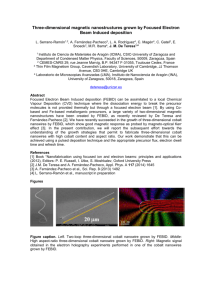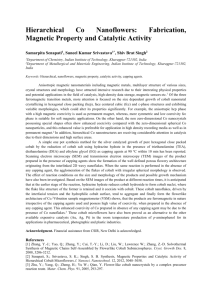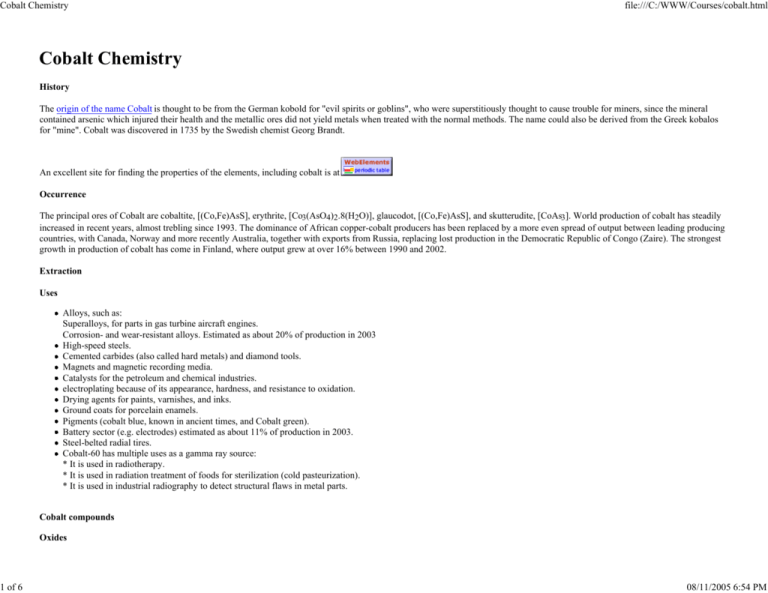
Cobalt Chemistry
1 of 6
file:///C:/WWW/Courses/cobalt.html
Cobalt Chemistry
History
The origin of the name Cobalt is thought to be from the German kobold for "evil spirits or goblins", who were superstitiously thought to cause trouble for miners, since the mineral
contained arsenic which injured their health and the metallic ores did not yield metals when treated with the normal methods. The name could also be derived from the Greek kobalos
for "mine". Cobalt was discovered in 1735 by the Swedish chemist Georg Brandt.
An excellent site for finding the properties of the elements, including cobalt is at
Occurrence
The principal ores of Cobalt are cobaltite, [(Co,Fe)AsS], erythrite, [Co3(AsO4)2.8(H2O)], glaucodot, [(Co,Fe)AsS], and skutterudite, [CoAs3]. World production of cobalt has steadily
increased in recent years, almost trebling since 1993. The dominance of African copper-cobalt producers has been replaced by a more even spread of output between leading producing
countries, with Canada, Norway and more recently Australia, together with exports from Russia, replacing lost production in the Democratic Republic of Congo (Zaire). The strongest
growth in production of cobalt has come in Finland, where output grew at over 16% between 1990 and 2002.
Extraction
Uses
Alloys, such as:
Superalloys, for parts in gas turbine aircraft engines.
Corrosion- and wear-resistant alloys. Estimated as about 20% of production in 2003
High-speed steels.
Cemented carbides (also called hard metals) and diamond tools.
Magnets and magnetic recording media.
Catalysts for the petroleum and chemical industries.
electroplating because of its appearance, hardness, and resistance to oxidation.
Drying agents for paints, varnishes, and inks.
Ground coats for porcelain enamels.
Pigments (cobalt blue, known in ancient times, and Cobalt green).
Battery sector (e.g. electrodes) estimated as about 11% of production in 2003.
Steel-belted radial tires.
Cobalt-60 has multiple uses as a gamma ray source:
* It is used in radiotherapy.
* It is used in radiation treatment of foods for sterilization (cold pasteurization).
* It is used in industrial radiography to detect structural flaws in metal parts.
Cobalt compounds
Oxides
08/11/2005 6:54 PM
Cobalt Chemistry
2 of 6
file:///C:/WWW/Courses/cobalt.html
Formula
Colour
Oxidation State
Cobalt oxides
MP
Structure / comments
Co3+
Co2O3
Co3O4
black
Co2+/3+
900-950decomp
normal spinel
CoO
olive green
Co2+
1795
NaCl -antiferromag. < 289 K
Preparations:
Co2O3 is formed from oxidation of Co(OH)2.
CoO when heated at 600-700°C converts to Co3O4
Co3O4 when heated at 900-950°C reconverts back to CoO.
no stable [Co(H2O)6]3+ or [Co(OH)3 exist since these convert to CoO(OH).
[Co(H2O)6]2+ not acidic and a stable carbonate exists.
Cobalt Blue
One of the earliest uses of Cobalt was in the colouring of glass by the addition of cobalt salts.
The pigment is based on the spinel CoAl2O4 and in the laboratory can be readily synthesised by pyrolysis of a mixture of AlCl3 and CoCl2.
Halides
Formula
Colour
CoF2
pink
Cobalt(II) halides
MP
1200
µ(BM)
Structure
-
rutile
08/11/2005 6:54 PM
Cobalt Chemistry
3 of 6
file:///C:/WWW/Courses/cobalt.html
CoCl2
blue
724
5.47
CdCl2
CoBr2
green
678
-
CdI2
CoI2
blue-black
515
-
CdI2
Preparations:
Co or CoCO3 + HX → CoX2.aq → CoX2
Cobalt complexes
The Cobalt(III) ion forms many stable complexes, which being inert, are capable of exhibiting various types of isomerism. The preparation and characterisation of many of these
complexes dates back to the pioneering work of Werner and his students.
Coordination theory was developed on the basis of studies of complexes of the type:
Werner Complexes
[Co(NH3)6]Cl3
yellow
[CoCl(NH3)5]Cl2
red
trans-[CoCl2(NH3)4]Cl
green
cis-[CoCl2(NH3)4]Cl
purple
Another important complex in the history of coordination chemistry is hexol. This was the first complex that could be resolved into its optical isomers that did not contain carbon atoms.
Since then, only three or four others have been found.
Recently a structure that Werner apparently misassigned has been determined to be related to the original hexol although in this case the complex contains 6 Co atoms, i.e. is
hexanuclear. The dark green compound is not resolvable into optical isomers.
Werner's hexol and "2nd hexol"
Highlight the Co and O sites
Highlight the Co and O sites
Reset the sites
Reset the sites
A noticeable difference between chromium(III) and cobalt(III) chemistry is that cobalt complexes are much less susceptible to hydrolysis, though limited hydrolysis, leading to
08/11/2005 6:54 PM
Cobalt Chemistry
4 of 6
file:///C:/WWW/Courses/cobalt.html
polynuclear cobaltammines with bridging OH- groups, is well known.
Other commonly occurring bridging groups are NH2-, NH2- and NO2-, which give rise to complexes such as the bright-blue amide bridged [(NH3)5Co-NH2-Co(NH3) 5]5+.
In the preparation of cobalt(III) hexaammine salts by the oxidation in air of cobalt(II) in aqueous ammonia it is possible to isolate blue [(NH3)5Co-O2-Co(NH3) 5]4+. This is moderately
stable in concentrated aqueous ammonia and in the solid state but readily decomposes in acid solutions to Co(II) and O2, while oxidizing agents such as (S2O8)2- convert it to the green,
paramagnetic [(NH3)5Co-O2-Co(NH3) 5]5+ (µ300 = 1.7 B.M.).
In the brown compound both cobalt atoms are Co(III) and are joined by a peroxo group, O22-, this fits with the observed diamagnetism; in addition the stereochemistry of the central
Co-O-O-Co group is similar to that of H2O2.
The green compound is less straightforward. Werner thought that it too involved a peroxo group but in this instance bridging between Co(III) and Co(IV) atoms.
This could account for the paramagnetism, but EPR evidence shows that the 2 cobalt atoms are equivalent, and X-ray evidence shows the central Co-O-O-Co group to be planar with an
O-O distance of 131 pm, which is very close to the 128 pm of the superoxide, O2-, ion.
A more satisfactory formulation therefore is that of 2 Co(III) atoms joined by a superoxide bridge.
A range of Co(II) dioxygen complexes are known, some of which are able to reversibly bind O2 from the air. During WWII, some US aircraft carriers are reported to have used these
complexes as a solid source for oxy-acetylene welding. By slightly warming the solid complex the oxygen was released and when cooled again oxygen would be coordinated again.
Unlike an oxygen cylinder the solid would not explode if hit by a stray bullet!
[CosalenO2]
A laboratory experiment designed to measure the uptake of dioxygen by Cosalen is available online.
Co(acac)3 is a green octahedral complex of Co(III). In the case of Co(II) a comparison can be made to the Ni(II) complexes.
Ni(acac)2 is only found to be monomeric at temperatures around 200C in non-coordinating solvents such as n-decane. 6-coordinate monomeric species are formed at room temperature
in solvents such as pyridine, but in the solid state Ni(acac)2 is a trimer, where each Ni atom is 6-coordinate. Note that Co(acac)2 actually exists as a tetramer.
08/11/2005 6:54 PM
Cobalt Chemistry
5 of 6
file:///C:/WWW/Courses/cobalt.html
[Ni(acac) 2]3
[Co(acac)2]4
Cobalt(II) halide complexes with pyridine show structural isomerism. Addition of pyridine to cobalt(II) chloride in ethanol can produce blue, purple or pink complexes each having the
composition "CoCl2pyr2". The structures are 4, 5 and 6 coordinate with either no bridging chlorides or mono- or di- bridged chlorides.
blue-[CoCl2pyr2] CN=4
pink-[CoCl2pyr2] CN=6
See the notes on isomerism for examples of Co(III) compounds that show linkage and structural isomerism.
Health
see the notes at The University of Bristol on Vitamin B12 and other Cobalt species essential for good health.
return to the C21J course outline
08/11/2005 6:54 PM
Cobalt Chemistry
6 of 6
file:///C:/WWW/Courses/cobalt.html
Return to Chemistry, UWI-Mona, Home Page
Copyright © 2005 by Robert John Lancashire, all rights reserved.
Created and maintained by Prof. Robert J. Lancashire
The Department of Chemistry, University of the West Indies,
Mona Campus, Kingston 7, Jamaica.
Created July 2002. Links checked and/or last modified 7th November 2005.
URL http://wwwchem.uwimona.edu.jm/courses/cobalt.html
08/11/2005 6:54 PM

